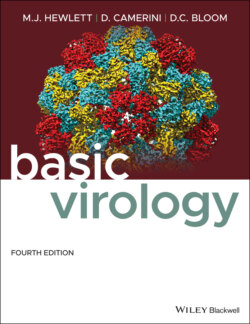Читать книгу Basic Virology - Martinez J. Hewlett - Страница 34
Multiplication of virus to high levels – occurrence of disease symptoms
ОглавлениеViral replication at specific target tissues often defines symptoms of the disease. The nature of the target and the host response are of primary importance in establishing symptoms. The ability of a virus to replicate in a specific target tissue results from specific interactions between viral and cellular proteins. In other words, one or another viral protein can recognize specific molecular features that define those cells or tissues favored for virus replication. These virus‐encoded proteins, thus, have a major role in specifying the virus's tissue tropism. Host factors, such as speed of immune response and inflammation, also play a major role. For example, a head cold results from infection and inflammation of the nasopharynx. Alternatively, liver malfunction due to inflammatory disease (hepatitis) could result from a viral infection in this critical organ.
One major factor in viral tropism is the distribution and occurrence of specific viral receptors on cells in the target tissue. The role of such receptors in the infection process is described in Part II, Chapter 6. For the purposes of the present discussion, it is enough to understand that there must be a specific and spatially close interaction between proteins at the surface of the virus and the surface of the cell's plasma membrane for the virus to be able to begin the infection process.
One example of the role of receptors in tissue tropism involves the poliovirus receptor, which is found on cells of the intestinal mucosa and in lymphatic tissue. A related molecule is also present on the surface of motor neurons, which means that neurotropic strains of poliovirus can invade, replicate in, and destroy these cells under certain conditions of infection. In another example, HIV readily infects T lymphocytes by recognizing the CD4 surface protein in association with a specific chemokine receptor that serves as a coreceptor. Rabies virus's ability to remain associated with nervous tissue probably is related to its use of the acetylcholine receptor present at nerve cell synapses. The ability of vaccinia virus (like the related smallpox virus) to replicate in epidermal cells is the result of its use of the epidermal growth factor receptor on such cells as its own receptor for attachment.
While tissue tropism is often understandable in terms of a specific viral receptor being present on the surface of susceptible cells, the story can be quite complicated in practice. This is the case for Epstein–Barr virus(EBV), which is found in B lymphocytes in patients who have been infected with the virus. It is thought that primary infection of epithelial cells in the mucosa of the nasopharynx, followed by association with lymphocytes during development of the immune response, leads to infection of B cells that carry the EBV‐specific receptor, CD21.
Even though the infection of target tissue is usually associated with the occurrence of symptoms of that viral infection, the target is not always connected with the spread of a virus subsequent to infection. For example, HIV infection can be readily spread from an infected individual long before any clinical symptoms of the disease (AIDS) are apparent. An individual can undergo a subclinical reactivation episode where there is virus in the saliva, but no fever blister can transmit HSV. Finally, paralytic polio is the result of a “dead‐end” infection of motor neurons, and the resulting death of those neurons and paralysis have nothing to do with spread of the virus.
